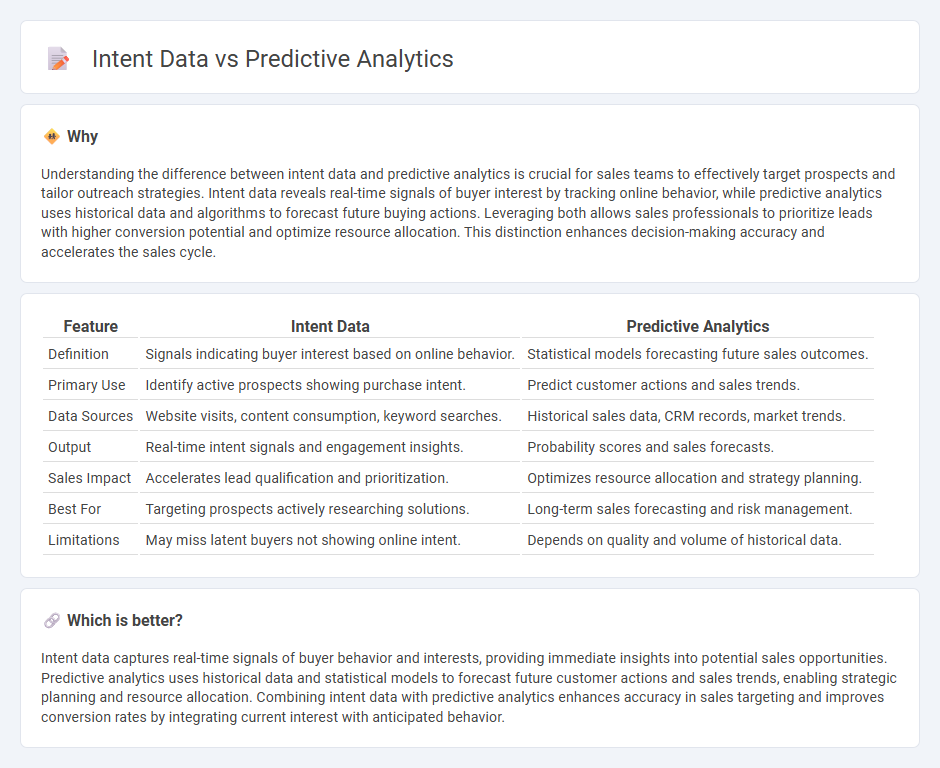
Intent data captures real-time signals from potential buyers indicating their interest and purchase intent, providing marketers with actionable insights to engage leads more effectively. Predictive analytics uses historical data and machine learning algorithms to forecast future customer behaviors and sales outcomes, enabling businesses to strategize proactively. Explore how intent data and predictive analytics can transform your sales process for better results.
Why it is important
Understanding the difference between intent data and predictive analytics is crucial for sales teams to effectively target prospects and tailor outreach strategies. Intent data reveals real-time signals of buyer interest by tracking online behavior, while predictive analytics uses historical data and algorithms to forecast future buying actions. Leveraging both allows sales professionals to prioritize leads with higher conversion potential and optimize resource allocation. This distinction enhances decision-making accuracy and accelerates the sales cycle.
Comparison Table
| Feature | Intent Data | Predictive Analytics |
|---|---|---|
| Definition | Signals indicating buyer interest based on online behavior. | Statistical models forecasting future sales outcomes. |
| Primary Use | Identify active prospects showing purchase intent. | Predict customer actions and sales trends. |
| Data Sources | Website visits, content consumption, keyword searches. | Historical sales data, CRM records, market trends. |
| Output | Real-time intent signals and engagement insights. | Probability scores and sales forecasts. |
| Sales Impact | Accelerates lead qualification and prioritization. | Optimizes resource allocation and strategy planning. |
| Best For | Targeting prospects actively researching solutions. | Long-term sales forecasting and risk management. |
| Limitations | May miss latent buyers not showing online intent. | Depends on quality and volume of historical data. |
Which is better?
Intent data captures real-time signals of buyer behavior and interests, providing immediate insights into potential sales opportunities. Predictive analytics uses historical data and statistical models to forecast future customer actions and sales trends, enabling strategic planning and resource allocation. Combining intent data with predictive analytics enhances accuracy in sales targeting and improves conversion rates by integrating current interest with anticipated behavior.
Connection
Intent data captures prospective customers' online behaviors and signals indicating purchase interest, while predictive analytics uses this data to forecast future buying actions and optimize sales strategies. By analyzing intent data patterns, predictive models identify high-probability leads and personalize outreach efforts, increasing conversion rates. Integrating intent data with predictive analytics enables sales teams to prioritize resources effectively and tailor marketing campaigns for maximum impact.
Key Terms
Forecasting
Predictive analytics leverages historical data and statistical algorithms to forecast future trends and behaviors, enabling businesses to anticipate customer needs and market shifts. Intent data captures real-time signals and online behaviors that indicate a prospect's specific interests and buying intent, providing immediate insights for targeted marketing. Explore how combining predictive analytics with intent data enhances forecasting accuracy and drives smarter decision-making.
Lead Scoring
Predictive analytics leverages historical data and machine learning algorithms to forecast lead behavior and prioritize prospects based on likelihood to convert, while intent data captures real-time signals indicating a prospect's current interests and buying intent. Combining predictive analytics with intent data enhances lead scoring accuracy by integrating predictive models with insights from prospect engagement patterns. Explore more to understand how integrating both approaches can optimize your lead scoring strategy.
Buyer Signals
Predictive analytics uses historical data and machine learning algorithms to identify patterns and forecast future buyer behaviors, helping businesses anticipate needs and optimize marketing strategies. Intent data captures real-time digital signals indicating a buyer's current interests and purchase intent, enabling more precise targeting and timely engagement. Explore how combining predictive analytics with intent data enhances buyer signal insights for smarter decision-making.
Source and External Links
What is Predictive Analytics? | IBM - Predictive analytics uses historical data, statistical modeling, data mining, and machine learning to identify patterns and predict future outcomes, often applied in risk assessment and opportunity identification.
What is predictive analytics and how does it work? | Google Cloud - Predictive analytics employs data analysis, machine learning, AI, and statistical models to forecast future trends and behaviors by analyzing historical and current data.
A Guide To Predictive Analytics | Tableau - Predictive analytics applies data mining, statistics, AI, and data modeling to historical data to forecast likely future events, enabling businesses to be proactive in decision-making.
 dowidth.com
dowidth.com